Which Of The Following Is An Example Of An Organizational Source Of Resistance Toã¢â‚¬â€¹ Change?
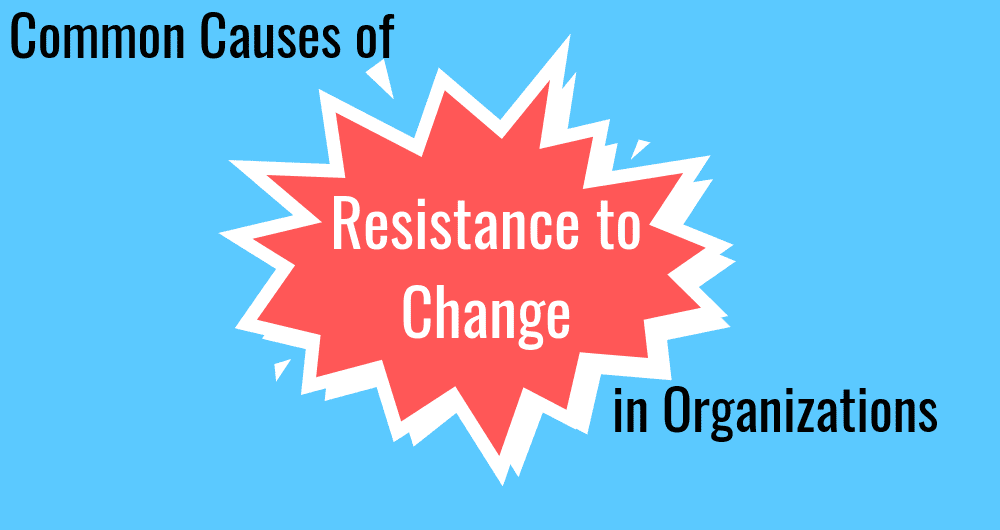
Information technology's easy to get excited almost making changes in an organization when you're the force behind the change, but anybody else may not share your enthusiasm.
Imagine a scenario where you're implementing a new CRM for your organisation. You've been working on this projection in the background for a while, so you are ready to get started, merely y'all're getting resistance to change from all sides that are greatly impacting your alter management programme.
Some people are earthworks in their heels and refusing to adopt the new system. Others are frustrated and confused past the software but are afraid to speak up. Meanwhile, morale is depression, and tensions are high. If the situation is mishandled, the transition to the new CRM is spring to fail.
While resistance is inevitable, it'due south not insurmountable. To overcome it, you must empathize the reasons behind the resistance and piece of work to get past them.
What Is Resistance to Change?
Resistance to modify is the reluctance of adapting to change when it is presented. Employees can exist either overt or covert near their unwillingness to adapt to organizational changes. This tin can range from expressing their resistance publicly to unknowingly resisting change through their language or general actions.
Download our pack of six change management templates to kick start your change intiatives
5 Almost Mutual Reasons for Organizational Change Resistance in 2022
While in that location can be an countless number of reasons why an employee is resistant to organizational alter, here are the five well-nigh common reasons.
i. Mistrust and Lack Of Confidence
When employees do non trust or feel confident in the person making the change, their resistance to it can exist a huge bulwark. In fact, alter advisor and author Rick Maurer believes that lack of confidence in modify-makers is a crusade of resistance to change in organizations that are most oft disregarded.
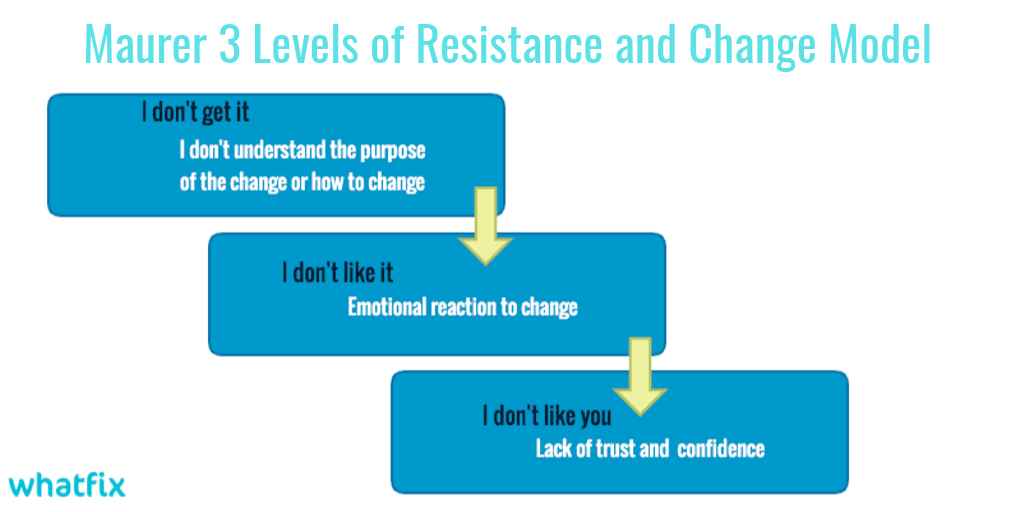
Maurer's 3 Levels of Resistance to Change are: I don't get information technology, I don't similar information technology, and I don't like yous. That'due south correct — people may not resist the change itself simply rather the person making it. Of course, "yous" does not ever refer to the change-maker specifically. Information technology could also be someone the alter-maker represents, such as corporate headquarters or a faceless CEO.
two. Emotional Responses
Changing the status quo is difficult, and many people volition have emotional reactions to anything that upsets their routine. This is a natural and inevitable response. Brushing it off volition only lead to stronger resistance.
Use change direction models that focus on emotional reactions to modify, such as the Kübler-Ross Change Bend or Bridges Transition Model, to mitigate this common crusade of resistance to alter. Both models recognize that alter sometimes leads to feelings of loss and grief. As such, change-makers must be prepared to manage these emotions and move people towards acceptance of the change.
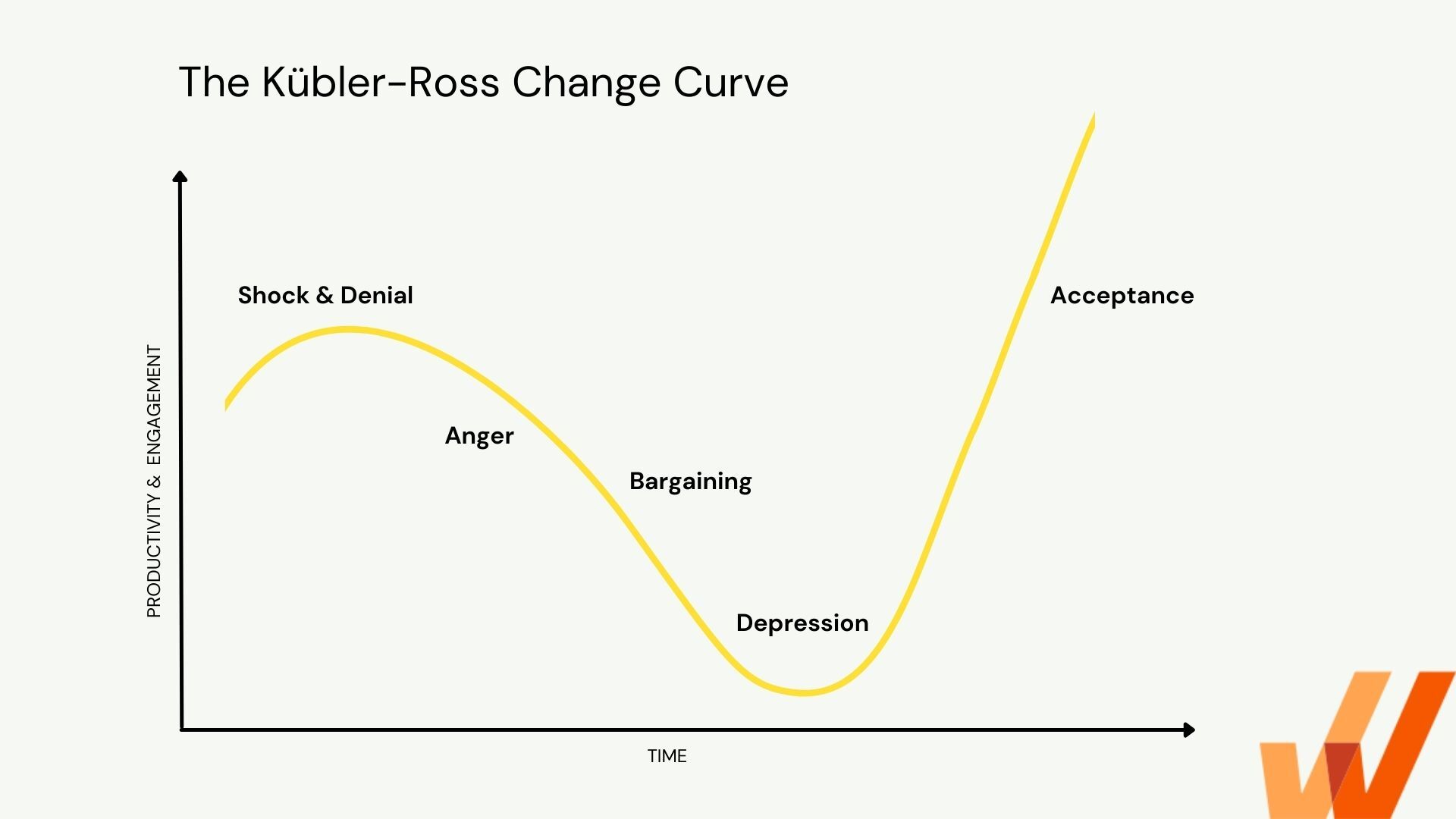
Begin past coaching change leaders to arroyo resistance to modify with empathy, recognizing that people will accept a wide range of emotional reactions. Some may fifty-fifty skip steps in the Kübler-Ross Modify Curve or slide dorsum to negative reactions multiple times throughout the transition.
In order to manage these reactions, change leaders should clearly explain the need for change while as well listening attentively to the feedback from those afflicted by information technology. People want to feel heard. Brand it clear that their opinions are valuable to the modify procedure. Additionally, change leaders should check in frequently to provide support, gather boosted feedback, and nudge people towards change acceptance and adoption.
3. Fright of Failure
People will not support a change if they're non confident in their ain abilities to suit to it. When people feel threatened past their own shortcomings (real or imagined), they protect themselves from failure by resisting the alter.
The ADKAR Model has two goals that address the fear of failure: knowledge and ability.
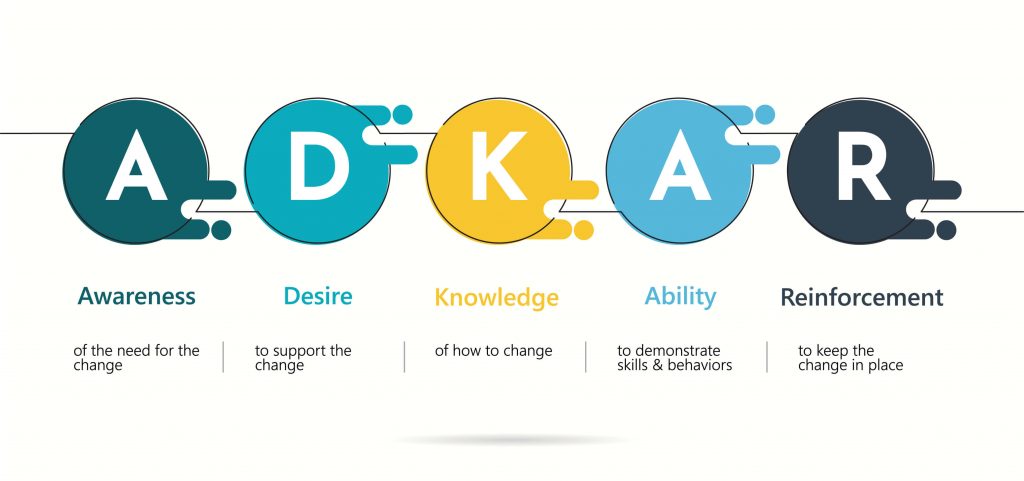
Cognition is nearly grooming. The goal is to give people the tools they need to brand the change, including those needed to handle transitions. Let'southward accept a technological change as an case. If your company is integrating a new software arrangement, employees should know how to move existing information into it, equally well as how to brand the most of the new system in the future.
Ability is more than nigh self-confidence. Later training, people need to feel comfy applying the knowledge they take acquired. Give employees enough hands-on experience to develop and exam their new skills earlier fully launching the alter.
4. Poor Communication
The key to dandy change management communication is to create an agile conversation. When you talkat people every bit opposed towith people, you're jump to become resistance to change.
First by making a alter advice plan. Before you initiate change, you lot should have several advice actions planned, such as the announcement of the modify, pocket-sized group discussions, ane-on-1 meetings, and methods for gathering feedback.
When talking with employees well-nigh change, answer the questions, "What'southward in it for me?" (WIIFM) and "What does information technology mean to me?" (WDIMTM). When you lot entreatment to individual concerns, you increase their appointment. People desire to know how the modify volition benefit them specifically and what they will need to do to implement and solidify the change.
Furthermore, providing continuous motivation throughout the modify process is essential. In fact, Kotter'southward 8-Stride Change Theory highlights the importance of focusing on short-term wins in step six of the eight-footstep alter procedure. When employees are recognized for their efforts, it builds their enthusiasm as well as their want to support the modify.
five. Unrealistic Timelines
Detect a remainder between creating a sense of urgency and allowing time to transition. Don't force change too apace. When you push also hard for a alter to happen, information technology's piece of cake to get tunnel vision and neglect important elements of your alter programme.
Begin with a change implementation timeline. Map out every action and prepare deadlines so that yous have a general idea of how long the entire transformation will accept. Often, designing the path between the current state and alter adoption helps you identify additional steps that are needed to facilitate the transition.
Of course, you should not be afraid to brand adjustments. If your team needs more time to understand the change or would do good from boosted training — make it happen.
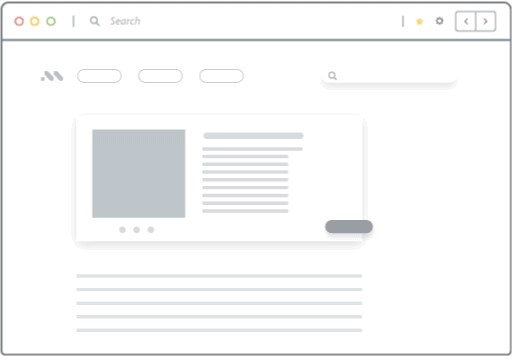
Back up your change projects with Whatfix's digital adoption platform
5 Tips to Overcome Resistance to Change
Hither are a few of the all-time strategies to overcome change resistance in your arrangement.
i. Show the Value in the New Modify by Educating Employees
A few of the main reasons why employees resistance alter is a lack of trust and a lack of communication. To avoid change resistance, provide proof that a new process, tool, or alter will greatly benefit them. Educate your employees on how this new change volition directly make their lives better.
2. Collect Employee Input Before a Change
Many times, employees resist alter because they believe their opinion doesn't affair and wouldn't impact the decision to make an organizational modify. Run surveys with your team on how they feel about the change and how they would make the process easier.
three. Come to an Understanding with Your Employees
Never make a decision without consulting those on the forepart lines – your employees. This is the instance with making the decision to implement a big change. Later consulting with your squad, come to an understanding on the timeline and overall plan for managing and implementing a new change.
4. Include Employees in the Modify Direction Plan
Employees feel they are taken seriously and their opinion matters when they're included in processes. Be certain to add key members of your team into the change management and implementation process and then they feel ownership of the project.
v. Support Your Employees During Organizational Transformation
Finally, don't leave your employees out on an isle – support your team members with resources, change management tools, noesis bases, and training on the new procedure or tool you're implementing. This volition assist your employees detect value in a new organization quickly, causing them to build trust with you when it comes time for a future change.
Conclusion: You Cannot Avoid It, But You Tin can Work Through It
Anticipating and planning for resistance is an essential aspect of implementing organizational modify. When yous dig into the reasons behind the resistance to change, y'all are improve prepared to accost it and move past it, regardless of which type of organizational modify you undergo inside your company.
If you're looking to build on your change management skills, we've compiled a listing of the all-time certification programs to opt for to attain an attestation of being an skilful in the field.
Lastly, exist certain to gather support for your change through change leaders, training tools, and employee appointment.
Go started with Whatfix to learn how we can design solutions that help in overcoming resistance to change through detailed guidance, faster onboarding, and ongoing support.
✓ Thank y'all, the template will be sent to your email
Download our complete guide to alter management for enterprises.
Subscribe to get new content delivered direct to your inbox.
Which Of The Following Is An Example Of An Organizational Source Of Resistance Toã¢â‚¬â€¹ Change?,
Source: https://whatfix.com/blog/causes-of-resistance-to-change/
Posted by: cardenwred1954.blogspot.com


0 Response to "Which Of The Following Is An Example Of An Organizational Source Of Resistance Toã¢â‚¬â€¹ Change?"
Post a Comment